 |
|
Tutor: micro bass amplifier
|
|
This
is a very simple project dedicated to those that want practice
guitar or bass and do not want to disturb neighbours and kids, 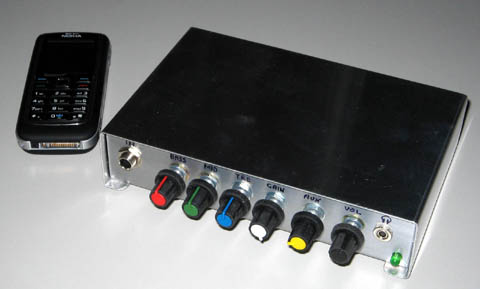 at every time, even at night, following the metronome or the tunes of
any "school" CD, those CD's which you find in many school books.
at every time, even at night, following the metronome or the tunes of
any "school" CD, those CD's which you find in many school books.
Of course you can challenge Jimi Hendrix or Jaco Pastorius, if you trust your fingers.
It is designed to be small and light, to be carried anywhere, so it is solid state and has a phone output.
|
|
Schematic
|
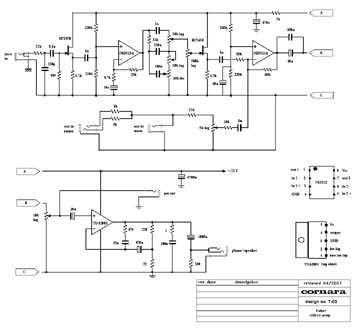 Here the schematic (click to enlarge). Here the schematic (click to enlarge).
It is built in two parts: the preamplifier and the power amp (well, power
is not the right word for this toy); the power supply is a standard 12V
from-the-shelf; any supply from 12 to 15 V is OK (perhaps 9V could be
enough, but I didn't try it).�
Pre -
mixer stage
Preamplifier includes a simple mixer, as it is designed to blend your
sound to any tune coming from a CD or from a metronome (generally
electronic metronomes have a phone output.
I used NE5532A and BF245B ... because they have excellent performances and are very easy to procure.
The input stage is a source follower based on FET BF245B, because
input impedance of NE5532A is too low for any passive pick up, followed
by the gain stage driving tone controls and gain control.
|
|
Despite the simplicity of the schematic, I didn't want to give up with
tone control, because IMHO I need to trim the tone of my instrument to
practice in an effective way.
The second source follower separates the gain control from the mixing stage, which has 10k input impedance.
This buffer is not necessary for the stereo and mono inputs because any CD player can drive a 25k load.
The mixer is inverting, of course, but this is not a problem.
The mixer drives the Master Volume pot; a main output (a standard jack
connector 6,3 mm) is connected to the Master Volume , to connect this
toy to any amplifier.�
Power (!) stage
It employs the classic TDA2003, which powered by 12V and 400mA can yeld 2 W on 8 ohm (with 800mA 4W on 4 ohm).
This power is too much to drive a phone (keep the Master low) but can
sound good and loud (OK, not too lous, of course) when connected to any
standard instrument cabinet (I'm speaking of 97 -
100 dB sensitivity, I tested it with my 12" cabinet and with a
Mark Bass 3x10 + tweeter and I decided that it is not possible to use
at night this way; with standard HiFi cabinets, usually not more than
90 dB, volume is ok).
The schematic comes from TDA2003 official datasheet, with components trimmed to 20 dB gain.
How I built it
As you see from the photos, it couldn't be simpler: an aluminium box (15/10 mm the frame, 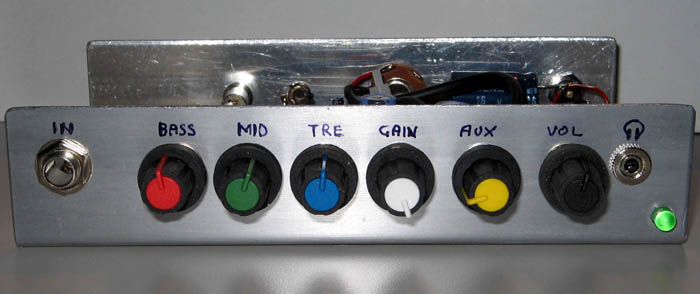 10/10 mm the cover) with a few holes, a fiberglass sheet , a 12 V 300mA supply from the junk box. 10/10 mm the cover) with a few holes, a fiberglass sheet , a 12 V 300mA supply from the junk box.
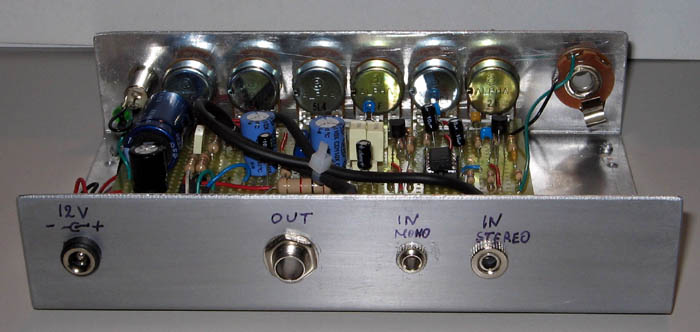
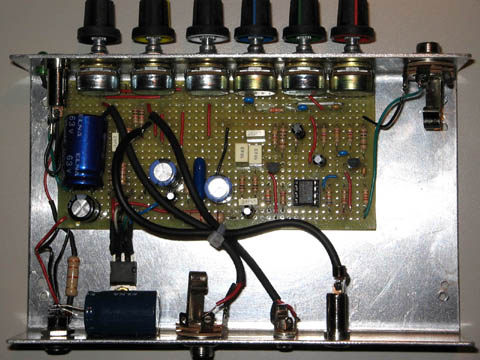
All resistors are 1/4 W.
The 4700 microF electrolytic you see on the power plug
recovers the hum caused by the low filtering of the cheap supply.
TDA2003 must be connected to the frame, which works as heat sink;
no problem because the case of the TDA2003 must be grounded.
|
|
|
| Final thoughts |
|
|
|
I didn't spend
that many words about this very very simple rig, the photos are more
than enough and the schematic doesn't contain any original idea,
everything comes from standard datasheets and application examples.
Voltage is very low and doesn't requires any care.
It works, the sound is good both by phones and by speaker, it fits the purpose it was designed to.
The realization doesn't requires long time, a weekend should be enough.
A better power supply (15 + 15 V) coul improve the performance of the
preamplifier, but not with TDA2003 which must be powered by
not more tha 18 V.
In this case a different power amp, with any of the integrated you can
find on the shelf, could yeld 20 or 30 W with few dollars, with a very
good value for money.
|
|
|
|